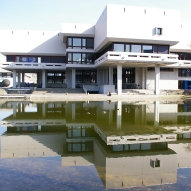Zusammenfassung
The kinetics of alc. oxidn. catalyzed by the enzyme horse liver alc. dehydrogenase (HLADH) is studied in water/alc./C12E23 systems with a series of n-alcs. ranging from ethanol to 1-decanol or with α,ω-alkandiols, namely, 1,5-pentanediol and 1,7-heptanediol. Essentially, the water-rich part of the ternary systems is examd., either without C12E23 or at several const. C12E23 concns. above the cmc ...
Zusammenfassung
The kinetics of alc. oxidn. catalyzed by the enzyme horse liver alc. dehydrogenase (HLADH) is studied in water/alc./C12E23 systems with a series of n-alcs. ranging from ethanol to 1-decanol or with α,ω-alkandiols, namely, 1,5-pentanediol and 1,7-heptanediol. Essentially, the water-rich part of the ternary systems is examd., either without C12E23 or at several const. C12E23 concns. above the cmc (1, 8, and 22%). The substrate inhibition of the enzyme allows one to infer alc. partition coeffs. between the outer aq. pseudophase and the surfactant aggregation pseudophase. In the case of short-chain n-alc. (ethanol, 1-propanol) and alkandiol (1,5-pentanediol) systems, the alc. seems to remain in the aq. pseudophase, whereas in the case of middle- and long-chain n-alc. (1-butanol to 1-decanol) and alkandiol (1,7-heptandiol) systems, the alc. participates in the structuration of the micelle.




 Altmetric
Altmetric